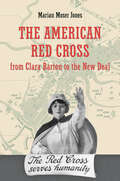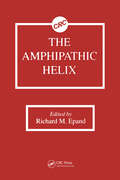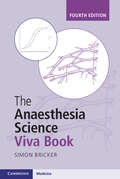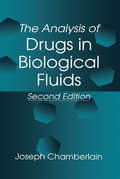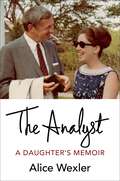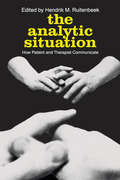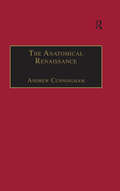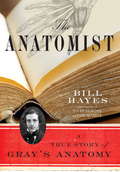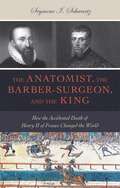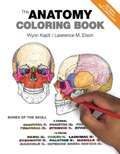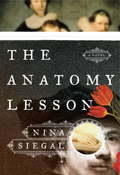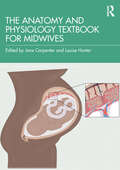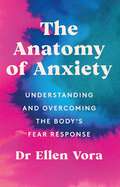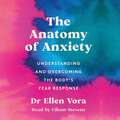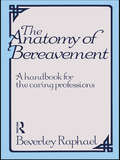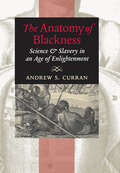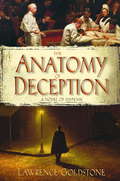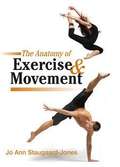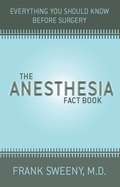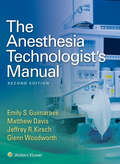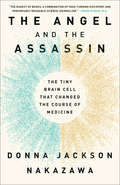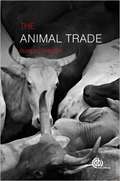- Table View
- List View
The American Red Cross: From Clara Barton to the New Deal
by Marian Moser JonesThe iconic relief organization&’s activities over a half century of history, through wars, epidemics, and other disasters: &“Well-researched . . . fascinating.&” —Julia F. Irwin, Bulletin of the History of Medicine In dark skirts and bloodied boots, Clara Barton fearlessly ventured onto Civil War battlefields to tend to wounded soldiers. She later worked with civilians in Europe during the Franco-Prussian War, lobbied legislators to ratify the Geneva conventions, and founded and ran the American Red Cross. The American Red Cross from Clara Barton to the New Deal tells the story of the charitable organization from its start in 1881, through its humanitarian aid during wars, natural disasters, and the Depression, to its relief efforts of the 1930s. Marian Moser Jones illustrates the tension between the organization&’s founding principles of humanity and neutrality and the political, economic, and moral pressures that sometimes caused it to favor one group at the expense of another. This book tells the stories of: • U.S. natural disasters such as the Jacksonville yellow fever epidemic of 1888, the Sea Islands hurricane of 1893, and the 1906 San Francisco earthquake • crises abroad, including the 1892 Russian famine and the Armenian massacres of 1895–96 • efforts to help civilians affected by the civil war in Cuba • power struggles within the American Red Cross leadership and subsequent alliances with the American government • the organization&’s expansion during World War I • race riots and massacres in East St. Louis, Chicago, and Tulsa between 1917 and 1921 • help for African American and white Southerners after the Mississippi flood of 1927 • relief projects during the Dust Bowl and after the New Deal An epilogue relates the history of the American Red Cross since the beginning of World War II and illuminates the organization&’s current practices and international reputation.
The Amphipathic Helix
by Richard M. EpandThe Amphipathic Helix is a comprehensive volume discussing amphipathic helices in systems as diverse as serum lipoproteins, lung surfactant, cytotoxic peptides, ion channels, mitochondrial targeting, peptide hormones, G proteins, T-cell recognition, DNA binding proteins, and antifreeze proteins. The book also includes general introductory material that defines amphipathic helices, discusses methods to identify amphipathic helical segments from the amino acid sequence of a protein, illustrates how amphipathic helices can be used in the de novo design of peptide and protein structures, and describes how these helices stabilize protein structures. There is also a section on techniques to determine helix orientation in a membrane environment using polarized attenuated total reflection infrared spectroscopy or solid state NMR spectroscopy. Recent developments on all these topics have been discussed by leading experts in this reference for researchers and students in biochemistry, biophysics, and pharmacology.
The Anaesthesia Science Viva Book
by Simon BrickerIn recent years the basic science viva of the Final FRCA has evolved a more clinical perspective. The new edition of the highly successful Anaesthesia Science Viva Book incorporates this new clinical emphasis, giving candidates an insight into the way the viva works, offering general guidance on exam technique, and providing readily accessible information relating to a wide range of potential questions. Questions are divided broadly into the four areas covered by the exam: applied anatomy, physiology, pharmacology and clinical measurement. Answers have been constructed to provide candidates with more than enough detail to pass the viva. Covering the full scope of the basic science syllabus, and written by an experienced FRCA examiner, The Anaesthesia Science Viva Book, Second Edition, is an essential purchase for every anesthesia student.
The Anaesthesia Science Viva Book
by Simon BrickerThe fourth edition of the highly successful The Anaesthesia Science Viva Book provides detailed, accessible summaries of the core questions in anatomy, physiology, pharmacology, and clinical measurement and equipment that may be covered in the oral part of the Final FRCA exam. In addition to a comprehensive update, this edition includes new subject material in each of the four basic sciences, with over 200 condensed summaries of the most relevant topics in the examination. Continuing to offer candidates an insight into the way the viva works, the book provides general guidance on examination technique, and readily accessible information relating to a wide range of potential questions. Written by a former senior examiner for the Diploma of the Fellowship of the Royal College of Anaesthetists, with previous editions recommended by Anaesthesia UK, formerly a prime educational resource for trainee anaesthetists, the book remains an essential purchase for every Final FRCA candidate.
The Anaesthesia Science Viva Book: Clinical Science As Applied To Anaesthesia, Intensive Therapy And Chronic Pain, A Guide To The Oral Questions
by Simon Bricker Bricker Celyn Celyn BrickerThis third edition of the highly successful The Anaesthesia Science Viva Book contains detailed, accessible summaries of the core questions in anatomy, physiology, pharmacology and clinical measurement that may be asked in the oral section of the Final FRCA exam. In addition to comprehensive updating of all the topics, this edition includes new subject material in each of the four basic sciences, with almost 200 detailed summaries of the most relevant topics in the examination. This volume once again gives candidates an insight into the way the viva works; offering general guidance on exam technique, and providing readily accessible information relating to a wide range of potential questions. Written by a former senior examiner for the diploma of the Fellowship of the Royal College of Anaesthetists and listed as recommended reading by AnaesthesiaUK, the prime educational resource for trainee anaesthetists, it remains an essential purchase for every Final FRCA candidate.
The Analysis of Drugs in Biological Fluids
by Joseph ChamberlainThis new edition focuses on a variety of techniques available for the analysis of drugs in biological fluids. Over 150 figures and tables help to describe the latest advances and give examples of their applications. Current chiral analysis methods as well as discussions on the impact of chirality are described. Practical aspects of bioanalytical work, including many examples of laboratory problems not often reported in the scientific literature, are examined in depth.
The Analyst: A Daughter's Memoir
by Alice WexlerMilton Wexler was among the most unconventional, compelling, and sometimes controversial figures of the golden age of psychoanalysis in America. From Teachers College at Columbia University to the Menninger Foundation in Topeka to the galleries and gilded hills of Hollywood, he traversed the country and the century, pursuing interests ranging from the treatment of schizophrenia to group therapy with artists to advocacy for research on Huntington’s disease. At a time when psychologists and psychoanalysts tended to promote adjustment to society, Wexler increasingly championed creativity and struggle.The Analyst is an intimate and searching portrait of Milton Wexler, written by his daughter, an acclaimed historian. Alice Wexler illuminates her father’s intense private life and explores how his life and work reveal the broader reaches of Freudian ideas in the United States. She draws on decades of Milton Wexler’s unpublished family and professional correspondence and manuscripts as well as her own interviews, diaries, and memories. Through the lens of Milton Wexler’s friendships, the book offers glimpses into the lives of cultural icons such as Lillian Hellman, Eppie Lederer (Ann Landers), and Frank Gehry. The Analyst is at once a striking account of the arc of an iconoclast’s life, a daughter’s moving meditation on her complex father, and a new window onto on the wider landscape of psychoanalysis and science in the twentieth century.
The Analytic Situation: How Patient and Therapist Communicate
by Peter F. DruckerSignificant as has been the role of psychoanalysis and psychotherapy in contemporary culture and society, its importance continues to grow at an accelerating rate as more specific, focused, and involving forms of therapy are devised. The contributions of eminent practitioners that make up this volume deal with specific types of occurrences in the confrontation between patient and therapist, such as silence, crying, sleeping, touching, use of first names, gifts, note taking, termination, etc. The views expressed here demonstrate how the rigidity of early psychoanalytic theory has yielded to fundamental changes in the handling of the analytic situation; numerous new schools of thought have arisen in attempts to give deeper fulfillment to the needs of patient, analyst, and society. The persuasions of these new schools--Gestaltist, existentialist, neo-Freudian, behavioralist, ego psychologist, rational-emotive, encounter, and many others--underlie the material presented here.Impulsiveness and originality mark all of these departures from orthodoxy. The therapist, becoming more open and more manifestly responsive in his interaction with the patient, is clearly shifting his role from that of an objective listener and interpreter to that of an overt participant in therapy. These trends are further intensified by the fact that the practice of psychotherapy is now carried on, by a vast number of clinical psychologists, personality psychologists, social psychologists, and social workers who have taken up psychotherapy as a professional activity in urban mental health clinics and in a variety of settings outside the major American metropolitan areas.The Analytic Situation provides informative, revealing reading for everyone involved in the psychotherapeutic process. It also offers provocative insights to students and therapists in training.
The Anatomical Renaissance: The Resurrection of the Anatomical Projects of the Ancients
by Andrew CunninghamThe central proposition of this book is that the great anatomists of the Renaissance, from Vesalius to Fabricius and Harvey - the forebears of modern scientific biology and medicine - consciously resurrected not merely the methods but also the research projects of Aristotle and other Ancients. The Moderns' choice of topics and subjects, their aims, and their evaluation of their investigations were all made in a spirit of emulation, not rejection, of their distant predecessors. First published in 1997, Andrew Cunningham’s masterly analysis of the history of the ’scientific renaissance' - a history not of things found, but of projects of enquiry - provoked a reappraisal of the intellectual roots of the Renaissance as well as illuminating debates on the history of the body and its images.
The Anatomist
by Bill Hayes"Hayes’s history of the illustrated medical text “Gray’s Anatomy” coincides with the hundred-and-fiftieth anniversary of its first publication. Fascinated by the fact that little was known about the famous book’s genesis, Hayes combed through nineteenth-century letters and medical-school records, learning that, besides Henry Gray, the brilliant scholar and surgeon who wrote the text, another anatomist was crucial to the book’s popularity: Henry Vandyke Carter, who provided its painstaking drawings. Hayes moves nimbly between the dour streets of Victorian London, where Gray and Carter trained at St. George’s Hospital, and the sunnier classrooms of a West Coast university filled with athletic physical therapists in training, where he enrolls in anatomy classes and discovers that “when done well, dissection is very pleasing aesthetically. ” -The New Yorker "All laud and honor to Hayes. . . . In perusing the body's 650 muscles and 206 bones, he has made the case that we are, as the psalmist wrote, "fearfully and wonderfully made" and that dissection has an aesthetic all its own. The act of carving open a body becomes, in this context, a perverse act of love, a desecration that consecrates "the extraordinary, the inner architecture of the human form. " -The Washington Post "How do you write a book about someone about whom next to nothing is known? For most writers, the answer would be move on to the next subject. But Bill Hayes has an unusual set of skills. The author of previous books on insomnia and blood, he is part science writer, part memoirist, part culture explainer. “The Anatomist,” his appealing new book about the man behind Gray’s Anatomy, combines his search for the remaining traces of Henry Gray with a memoir of his own experience as a dissection student and a scalpel’s-eye tour of the body. " -The New York Times "Some of [Hayes's] most memorable writing describes the dissection classes he attended in San Francisco. We are treated to a selection of fascinating anatomical snippets about, for example, how to trace evidence of the sealed hole in the fetal heart through which the mother's blood enters; or how to find the kidney in a cadaver; or that blood flowing out of the heart is first used to feed the heart itself; or, best of all, a structural analysis of how the Queen manages to deliver such a uniquely restrained wave. " -Nature: The International Weekly Journal of Science The classic medical text known asGray’s Anatomyis one of the most famous books ever written. Now, on the 150th anniversary of its publication, acclaimed science writer and master of narrative nonfiction Bill Hayes has written the fascinating, never-before-told true story of how this seminal volume came to be. A blend of history, science, culture, and Hayes’s own personal experiences, The Anatomist is this author’s most accomplished and affecting work to date. With passion and wit, Hayes explores the significance ofGray’s Anatomyand explains why it came to symbolize a turning point in medical history. But he does much, much more. Uncovering a treasure trove of forgotten letters and diaries, he illuminates the astonishing relationship between the fiercely gifted young anatomist Henry Gray and his younger collaborator H. V. Carter, whose exquisite anatomical illustrations are masterpieces of art and close observation. Tracing the triumphs and tragedies of these two extraordinary men, Hayes brings an equally extraordinary era–the mid-1800s–unforgettably to life. But the journey Hayes takes us on is not only outward but inward–through the blood and tissue and organs of the human body–forThe A
The Anatomist, the Barber-Surgeon, and the King
by Seymour I. SchwartzThis unique study examines a critical juncture in the history of the Renaissance brought about by a freak accident. Combining both a history of sixteenth-century medicine and European politics, the author describes the far-reaching effects of the death of King Henry II of France (1519-1559). Grievously wounded by an accidental blow to the head suffered during a mock jousting competition, the king lingered for weeks before expiring. Even the ministrations of Europe's two most renowned physicians--Andreas Vesalius and Ambroise Paré--could not prevent his demise. As the author shows, the death of Henry II created a power vacuum, and the subsequent chain of events had significant effects on the balance of power in Europe. A noted surgeon, the author also provides many insights into the state of medicine in this era--a time when the practice of surgery and knowledge of human anatomy were being transformed. Readers learn how Vesalius's ingenious studies of anatomy advanced the understanding of human body functions. And Paré's experience with battlefield wounds led to more humane and effective treatments of the injured. This colorful, lively narrative combines engrossing details about politics, history, and medicine during an important period at the end of the Renaissance.From the Hardcover edition.
The Anatomy Coloring Book
by Wynn Kapit Lawrence ElsonFor more than 35 years, The Anatomy Coloring Book has been the #1 best-selling human anatomy coloring book! <p><p>A useful tool for anyone with an interest in learning anatomical structures, this concisely written text features precise, extraordinary hand-drawn figures that were crafted especially for easy coloring and interactive study. Organized according to body systems, each of the 162 two-page spreads featured in this book includes an ingenious color-key system where anatomical terminology is linked to detailed illustrations of the structures of the body. When you color to learn with The Anatomy Coloring Book, you make visual associations with key terminology, and assimilate information while engaging in kinesthetic learning. Studying anatomy is made easy and fun! <p><p> The Fourth Edition features user-friendly two-page spreads with enlarged art, clearer, more concise text descriptions, and new boldface headings that make this classic coloring book accessible to a wider range of learners.
The Anatomy Lesson
by Nina SiegalSet in the Dutch Golden Age, an engrossing historical novel that brilliantly imagines the complex story behind one of Rembrandt's most famous paintingsCommissioned by the Amsterdam Surgeons' Guild, The Anatomy Lesson of Dr. Nicolaes Tulp was the first major Rembrandt work to catapult the young painter to international fame. Taking this painting as its inspiration, Nina Siegal's novel The Anatomy Lesson opens on the morning of the medical dissection and follows several characters as they prepare for the evening's big event: we meet Aris the Kid, a one-handed coat thief who is awaiting his turn at the gallows; Flora, the woman who is pregnant with his child and who hopes to save him from the executioner; Jan Fetchet, a curio collector who also moonlights as an acquirer of medical cadavers; René Descartes, who will attend the dissection in the course of his quest to understand where the human soul resides; and the twenty-six-year-old Dutch master himself, who feels a shade uneasy about this assignment. And in the twenty-first century, there is Pia, a contemporary art historian who is examining the painting. As the story builds to its dramatic and inevitable conclusion, the events that transpire throughout the day sway Rembrandt to make fundamental changes to his initial composition. Bringing to life the vivid world of Amsterdam in 1632, The Anatomy Lesson offers a rich slice of history and a textured story by a young master.
The Anatomy and Physiology Textbook for Midwives
by Jane Carpenter Louise HunterFocusing on optimising the normal biological processes of reproduction and early life, and in line with the Nursing and Midwifery Council (NMC) Future Midwives Standards, this comprehensive textbook introduces the fundamental anatomy and physiology knowledge needed for midwifery practice. This textbook follows the journey from preconception to the puerperium. Divided into six parts, it begins with foundational material before moving onto reproduction, embryology and fetal development. The central sections of the book consider maternal changes and adaptations during pregnancy, the intrapartum period, and the puerperium and transition from fetal to neonatal life. The book finishes with a section looking at lactation. Containing numerous full colour illustrations, each chapter includes 'Application to practice 'boxes, 'challenge' sections and 'interrupters' to help you consolidate your learning. The text is accompanied by a downloadable interactive workbook to complete as you read. Written in a clear and accessible style, The Anatomy and Physiology Textbook for Midwives is an essential read for preregistration midwifery students, studying at both BSc and MSc levels.
The Anatomy of Anxiety: Understanding and Overcoming the Body's Fear Response
by Dr Ellen Vora'A redeeming way to look at the condition, as not merely a burden but ultimately a blessing ... unexpectedly moving ... validating and hopeful' GuardianAnxiety. It's all in your head, right? Wrong.Psychiatrist Dr Ellen Vora challenges the conventional view of anxiety as a mental disorder, suggesting instead that much of what we call anxiety begins in the body. Rather than our troubled thoughts creating physical symptoms, she argues that many types of anxiety are the result of states of imbalance in our bodies, whether blood sugar crashes, caffeine highs or sleep deprivation.Her clinical observation shows this type of anxiety is far more preventable than we may realise, responding almost immediately to straightforward adjustments to diet and lifestyle.Backed by the latest scientific research and Dr Vora's own clinical work, The Anatomy of Anxiety offers a fresh, much needed look at mental health, offering actionable strategies for managing our moods.She further argues that other forms of anxiety, when listened to and honoured instead of suppressed, can be seen as a course correction to help nudge us back to a more balanced life.In her groundbreaking book, Dr Vora walks beside us through a healing process to reframe our relationship with anxiety, creating a more joyful and fulfilled life.
The Anatomy of Anxiety: Understanding and Overcoming the Body's Fear Response
by Dr Ellen Vora'A redeeming way to look at the condition, as not merely a burden but ultimately a blessing ... unexpectedly moving ... validating and hopeful' Guardian'An incredible paradigm shift in how we view anxiety' Dr Nicole LePera, author of international bestseller How to Do the WorkAnxiety. It's all in your head, right? Wrong.Psychiatrist Dr Ellen Vora challenges the conventional view of anxiety as a mental disorder, suggesting instead that much of what we call anxiety begins in the body. Rather than our troubled thoughts creating physical symptoms, she argues that many types of anxiety are the result of states of imbalance in our bodies, whether blood sugar crashes, caffeine highs or sleep deprivation.Her clinical observation shows this type of anxiety is far more preventable than we may realise, responding almost immediately to straightforward adjustments to diet and lifestyle.Backed by the latest scientific research and Dr Vora's own clinical work, The Anatomy of Anxiety offers a fresh, much needed look at mental health, offering actionable strategies for managing our moods.She further argues that other forms of anxiety, when listened to and honoured instead of suppressed, can be seen as a course correction to help nudge us back to a more balanced life.In her groundbreaking book, Dr Vora walks beside us through a healing process to reframe our relationship with anxiety, creating a more joyful and fulfilled life.
The Anatomy of Bereavement: A Handbook for the Caring Professions (The\caring Professions Ser.)
by Beverley RaphaelFirst published in 1985. Routledge is an imprint of Taylor & Francis, an informa company.
The Anatomy of Blackness: Science and Slavery in an Age of Enlightenment
by Andrew S. Curran2012 Outstanding Academic Title, Choice MagazineThis volume examines the Enlightenment-era textualization of the Black African in European thought. Andrew S. Curran rewrites the history of blackness by replicating the practices of eighteenth-century readers. Surveying French and European travelogues, natural histories, works of anatomy, pro- and anti-slavery tracts, philosophical treatises, and literary texts, Curran shows how naturalists and philosophes drew from travel literature to discuss the perceived problem of human blackness within the nascent human sciences, describes how a number of now-forgotten anatomists revolutionized the era’s understanding of black Africans, and charts the shift of the slavery debate from the moral, mercantile, and theological realms toward that of the "black body" itself. In tracing this evolution, he shows how blackness changed from a mere descriptor in earlier periods into a thing to be measured, dissected, handled, and often brutalized. Penetrating and comprehensive, The Anatomy of Blackness shows that, far from being a monolithic idea, eighteenth-century Africanist discourse emerged out of a vigorous, varied dialogue that involved missionaries, slavers, colonists, naturalists, anatomists, philosophers, and Africans themselves.
The Anatomy of Deception
by Lawrence GoldstoneA mesmerizing forensic thriller that thrusts the reader into the operating rooms, drawing rooms, and back alleys of 1889 Philadelphia, as a young doctor grapples with the principles of scientific process to track a daring killerIn the morgue of a Philadelphia hospital, a group of physicians open a coffin and uncover the corpse of a beautiful young woman. What they see takes their breath away. Within days, one of them strongly suspects that he knows the woman’s identity…and the horrifying events that led to her death. But in this richly atmospheric novel–an ingenious blend of history, suspense and early forensic science–the most compelling chapter is yet to come, as young Ephraim Carroll is plunged into a maze of murder, secrets and unimaginable crimes....Dr. Ephraim Carroll came to Philadelphia to study with a leading professor, the brilliant William Osler, believing that he would gain the power to save countless lives. As America hurtles toward a new century, medicine is changing rapidly, in part due to the legalization of autopsy–a crime only a few years before. But Carroll and his mentor are at odds over what they glimpsed that morning in the hospital’s Dead House. And when a second mysterious death is determined to have been a ruthless murder, Carroll can feel the darkness gathering around him–and he ignites an investigation of his own.Soon he is moving between the realm of elite medicine, Philadelphia high society, and a teeming badlands of criminality and sexual depravity along the city’s fetid waterfront. With a wealthy, seductive woman clouding his vision, the controversial artist Thomas Eakins sowing scandal, and the secrets of the nation’s powerful surgeons unraveling around him, Carroll is forced to confront an agonizing moral choice–between exposing a killer, undoing a wrong, and, quite possibly, protecting the future of medicine itself….From the Hardcover edition.
The Anatomy of Exercise And Movement: For the Study of Dance, Pilates, Sport and Yoga
by Jo Staugaard-JonesThis book serves as a bridge between biomechanics and the practice of sport, Pilates, yoga, and dance, providing the reader with a complete understanding of how the body functions while exercising.
The Anatomy of Sports Injuries, Second Edition: Your Illustrated Guide to Prevention, Diagnosis, and Treatment
by Brad WalkerFor anyone who plays sports and is looking to facilitate recovery or prevent injuriesEveryone who plays sports experiences injuries. Many people never fully recover because they're not aware of what they can do to facilitate recovery. But there's no need to simply resign yourself to "living with" a sports injury. In The Anatomy of Sports Injuries, author Brad Walker brings years of expertise--he works with elite-level and world-champion athletes, and lectures on injury prevention--to this how-to guide. The book takes a fundamental approach, bringing you inside the body to show exactly what is happening when a sports injury occurs. At the heart of The Anatomy of Sports Injuries are 350 images. This second edition includes updated illustrations and more anatomical information and is for every sports player or fitness enthusiast who has been injured and would like to know what the injury involves, how to rehabilitate the area, and how to prevent complications or injury in the future.
The Anesthesia Technologist's Manual: All You Need To Know For Study And Reference
by Jeffrey R. Kirsch Emily Guimaraes Matthew Davis Glenn WoodworthPublisher's Note: Products purchased from 3rd Party sellers are not guaranteed by the Publisher for quality, authenticity, or access to any online entitlements included with the product. This unique manual is an ideal resource for anesthesia technicians and technologists and those studying for certification (CerATT) in the field. It offers well-illustrated, comprehensive coverage of every aspect of day-to-day practice and workflow, with sections on Anatomy, Physiology, and Pharmacology; Anesthesia Practice; Anesthesia Equipment and Technology; Emergencies, and more. From explanations of who’s who in the operating room to detailed, step-by-step instructions on equipment maintenance, this practical manual ensures that readers will have current, complete information on the core knowledge they need to know in anesthesia technology.
The Angel and the Assassin: The Tiny Brain Cell That Changed the Course of Medicine
by Donna Jackson NakazawaA thrilling story of scientific detective work and medical potential that illuminates the newly understood role of microglia—an elusive type of brain cell that is vitally relevant to our everyday lives. &“The rarest of books: a combination of page-turning discovery and remarkably readable science journalism.&”—Mark Hyman, MD, #1 New York Times bestselling author of Food: What the Heck Should I Eat? Until recently, microglia were thought to be merely the brain&’s housekeepers, helpfully removing damaged cells. But a recent groundbreaking discovery revealed them to be capable of terrifying Jekyll and Hyde behavior. When triggered—and anything that stirs up the immune system in the body can activate microglia—they can morph into destroyers, impacting a wide range of issues from memory problems and anxiety to depression and Alzheimer&’s. Under the right circumstances, however, microglia can be coaxed back into being angelic healers, able to repair the brain in ways that help alleviate symptoms and hold the promise to one day prevent disease. A fascinating behind-the-scenes account of this cutting-edge science, The Angel and the Assassin also explores the medical implications of these game-changing discoveries. Award-winning journalist Donna Jackson Nakazawa began her investigation with a personal interest—when diagnosed with an autoimmune disorder years ago, she was convinced there was something physical going on in her brain as well as her body, though no doctor she consulted could explain how the two could be interacting in this way. With the compassion born of her own experience, she follows practitioners and patients on the front lines of treatments that help to &“reboot&” microglia—from neurofeedback and intermittent fasting to transcranial magnetic stimulation and gamma light flicker therapy. She witnesses patients finding significant relief from pressing symptoms—and at least one stunning recovery—offering new hope to the tens of millions who suffer from mental, cognitive, and physical health issues. Proving once and for all the biological basis for the mind-body connection, the discovery of the true role of microglia stands to rewrite psychiatric and medical texts as we know them. Hailed as &“riveting,&” &“stunning,&” and &“visionary,&” The Angel and the Assassin offers us a radically reconceived picture of human health and promises to change everything we thought we knew about how to heal ourselves.
The Animal Trade
by Clive PhillipsThe trade in live and dead animals and animal parts is a significant aspect of the global economy, but economic considerations are inevitably at odds with optimal animal welfare. Providing a snapshot of the current situation, this book discusses the background to modern international trade, welfare, and the environmental, economic and cultural issues. Covering farm, zoo and sport animals as well as the pet industry, the author draws together the competing interests and issues involved. Critically examining the overall ethics of the current situation and future of animal trade, he considers it within the context of food security, climate change, cultural sensitivities and consumer opinion.
